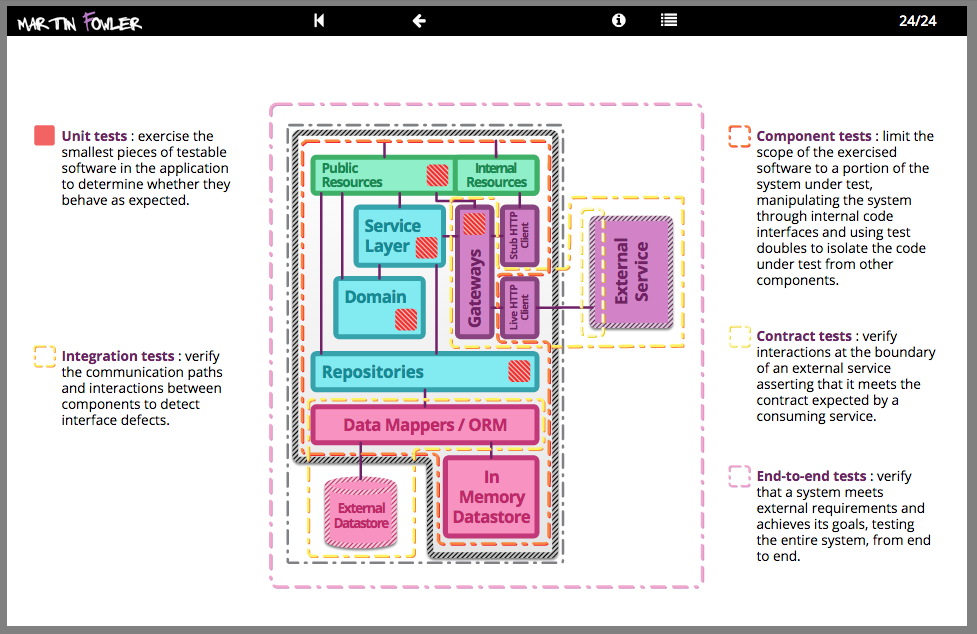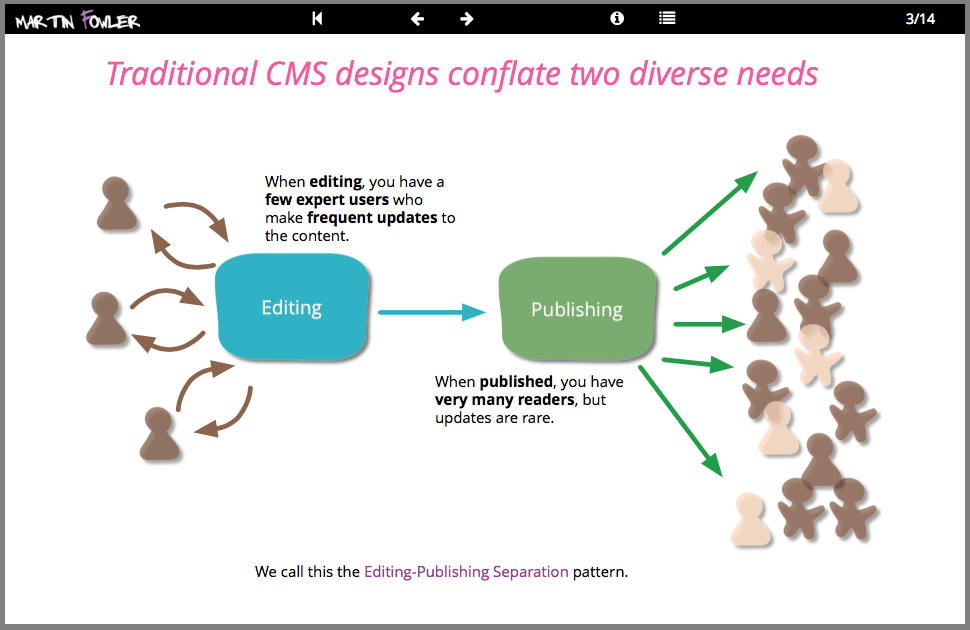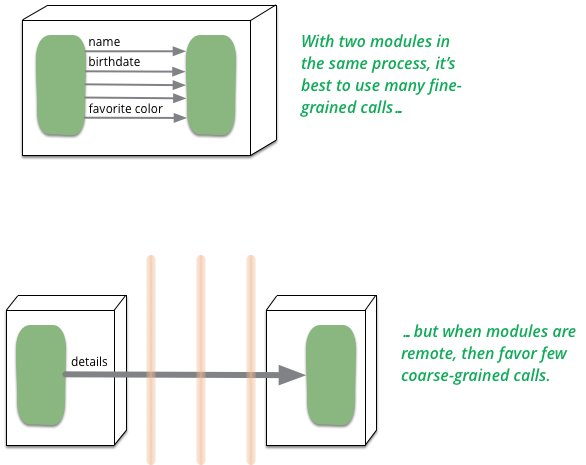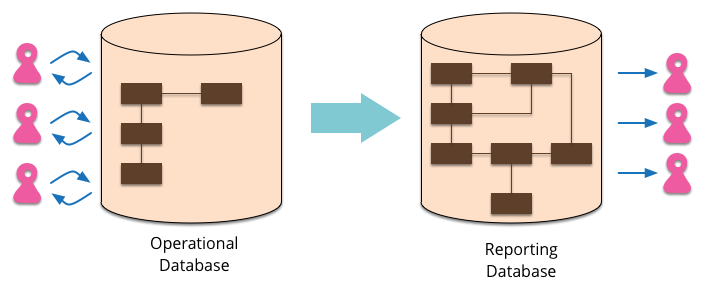during: 2014
Using the Rake Build Language
Rake is a build language, similar in purpose to make and ant. Like make and ant it's a Domain Specific Language, unlike those two it's an internal DSL programmed in the Ruby language. In this article I introduce rake and describe some interesting things that came out of my use of rake to build this web site: dependency models, synthesized tasks, custom build routines and debugging the build script.
APIs should not be copyrightable

APIs should not be copyrightable so that programmers can reimplement interfaces to support testing, interoperability, and to encourage competition.
Replacing Throwing Exceptions with Notification in Validations

If you're validating some data, you usually shouldn't be using exceptions to signal validation failures. Here I describe how I'd refactor such code into using the Notification pattern.
Garmin Oregon 600 - a brief review

Do I find any value in a dedicated handheld GPS device?
Privacy on the internet
At goto Aarhus 2014, the keynotes by myself, Erik Dörnenburg, and Tim Bray spent a good bit of time considering the issue of privacy on the internet. Afterwards Ola Bini got together with us to discuss this issue, the current state of affairs, and what we developers should be doing about it.
Testing Strategies in a Microservice Architecture

There has been a shift in service based architectures over the last few years towards smaller, more focussed “micro” services. There are many benefits with this approach such as the ability to independently deploy, scale and maintain each component and parallelize development across multiple teams. However, once these additional network partitions have been introduced, the testing strategies that applied for monolithic in process applications need to be reconsidered. Here, we plan to discuss a number of approaches for managing the additional testing complexity of multiple independently deployable components as well as how to have tests and the application remain correct despite having multiple teams each acting as guardians for different services.
Sony a6000 with 16-70mm lens

An informal review of the Sony a6000 mirrorless camera paired with the Sony-Zeiss 16-70mm lens.
The Architecture of the Morrison's OrderPad

Morrisons OrderPad is a tablet web-application that helps staff in supermarkets place orders for new stock as they walk around the store. The resulting application makes a good expositional architecture for a tablet web application backed by a lightweight java server application. We highlight the separation of application control and DOM interaction on the client, using small, focused frameworks on the server, the broad-stack testing environment, and the use of a pilot project to understand what features were needed.
Ruby Rogues Podcast on Refactoring
The Ruby Rogues is a popular podcast on programming in the Ruby world. They invited me back to discuss the Ruby edition of Refactoring. We talked about the definition of refactoring, why we find we don't use debuggers much, what might be done to modernize the book, the role of refactoring tools, whether comments can be used for good, the trade-off between refactoring and rewriting, modularity and microservices, and how the software industry has changed over the last twenty years.
Sacrificial Architecture

You're sitting in a meeting, contemplating the code that your team has been working on for the last couple of years. You've come to the decision that the best thing you can do now is to throw away all that code, and rebuild on a totally new architecture. How does that make you feel about that doomed code, about the time you spent working on it, about the decisions you made all that time ago?
Our Responsibility to Defeat Mass Surveillance
In our keynote for goto 2014, Erik and I consider an aspect of software professionals taking responsibility for how our software affects society. One of the primary concerns at the moment is privacy, which is being undermined by mass surveillance. Email is currently problematic because the movement of email to services has led to a concentration of email provision that makes it easier to monitor. We need to improve privacy by working to widen the use of encryption for email, so that the cost of mass surveillance becomes prohibitive. The challenge for this is primarily a challenge of user-experience and software packaging, not something that requires great understanding of cryptography.
Two Stack CMS

We build many websites with rich content, often using popular Content Management Systems (CMS). A recent project involved a marketing website for a global manufacturer which demanded complex interactive content with high availability and traffic needs. Our response was to apply the editing-publishing separation pattern and build two distinct stacks of software for content creation and delivery. In this deck you can see an overview of this architecture and our response to the issues of integration between the stacks, providing a secure preview of the live site, and handling the evolution and scaling of the system.
Setting up a ruby development VM with Vagrant, Chef, and rbenv
Some notes from my experiences in setting up a Vagrant VM to help collaborators use my web publishing toolchain. I used Chef to provision the VM and rbenv to install and control the right version of ruby.
Restoring a deleted note in Apple's notes app
I recently deleted a note on my Notes app on my apple laptop. As someone who is a paranoid keeper of backups, and usually commits all my work to a repository like git, I don't worry much about accidental deletion. But Apple's notes app doesn't have any form of version control, and it's all too easy to delete something by accident. I have a daily rsync backup and run time machine, but googling couldn't uncover a simple way of getting the note back. So in case someone else needs to do this, here's what I did.
Microservice Prerequisites

As I talk to people about using a microservices architectural style I hear a lot of optimism. Developers enjoy working with smaller units and have expectations of better modularity than with monoliths. But as with any architectural decision there are trade-offs. In particular with microservices there are serious consequences for operations, who now have to handle an ecosystem of small services rather than a single, well-defined monolith. Consequently if you don't have certain baseline competencies, you shouldn't consider using the microservice style.
Maturity Model

A maturity model is a tool that helps people assess the current effectiveness of a person or group and supports figuring out what capabilities they need to acquire next in order to improve their performance. In many circles maturity models have gained a bad reputation, but although they can easily be misused, in proper hands they can be helpful.
Shu Ha Ri
Shu-Ha-Ri is a way of thinking about how you learn a technique. The name comes from Japanese martial arts (particularly Aikido), and Alistair Cockburn introduced it as a way of thinking about learning techniques and methodologies for software development.
Microservices and the First Law of Distributed Objects

In P of EAA I said "don't distribute your objects". Does this advice contradict my interest in Microservices?
Canary Release
Canary release is a technique to reduce the risk of introducing a new software version in production by slowly rolling out the change to a small subset of users before rolling it out to the entire infrastructure and making it available to everybody.
Hexagonal Architecture and Rails
A couple of videos of a conversation between me and my colleague Badri about hexagonal architecture and its role in a Rails application. In the first video we talk about what Hexagonal Architecture means and how this leads into the choice between the Active Record and Data Mapper patterns for a persistance framework. In the second we move more broadly into the architectural role Rails should play in an application - should you see it as a platform, or a suite of components.
Goto Fail, Heartbleed, and Unit Testing Culture
Two computer security flaws were discovered in early 2014: Apple’s “goto fail” bug and OpenSSL’s “Heartbleed” bug. Both had the potential for widespread and severe security failures, the full extent of which we may never know. Given their severity, it is important for the software development profession to reflect on how they could have been detected so we can improve our ability to prevent these kinds of defects in the future. This article considers the role unit testing could play, showing how unit tests, and more importantly a unit testing culture, could have identified these particular bugs. It goes on to look at the costs and benefits of such a culture and describes how such a culture was instilled at Google.
Parallel Change
Making a change to an interface that impacts all its consumers requires two thinking modes: implementing the change itself, and then updating all its usages. This can be hard when you try to do both at the same time, especially if the change is on a PublishedInterface with multiple or external clients.
Parallel change, also known as expand and contract, is a pattern to implement backward-incompatible changes to an interface in a safe manner, by breaking the change into three distinct phases: expand, migrate, and contract.
Is TDD Dead?
David Heinemeier Hansson, the creator of Ruby on Rails, gave a keynote at RailsConf where he declared that TDD is Dead. This caused a predictably large amount of controversy in both the Rails and wider software development community. It also led to some interesting conversations between David, Kent, and myself. We decided that these conversations were interesting enough that others might like to watch them too, so recorded a series of video hangouts where we discuss the role of TDD in software development.
Unit Test

Unit testing is often talked about in software development, and is a term that I've been familiar with during my whole time writing programs. Like most software development terminology, however, it's very ill-defined, and I see confusion can often occur when people think that it's more tightly defined than it actually is.
Self Testing Code

Self-Testing Code is the name I used in Refactoring to refer to the practice of writing comprehensive automated tests in conjunction with the functional software. When done well this allows you to invoke a single command that executes the tests - and you are confident that these tests will illuminate any bugs hiding in your code.
Playlist of my talks on YouTube
Many of my talks are available on YouTube. Here is my playlist of talks that are on YouTube, which I do my best to keep up to date.
Reporting Database

Most EnterpriseApplications store persistent data with a database. This database supports operational updates of the application's state, and also various reports used for decision support and analysis. The operational needs and the reporting needs are, however, often quite different - with different requirements from a schema and different data access patterns. When this happens it's often a wise idea to separate the reporting needs into a reporting database, which takes a copy of the essential operational data but represents it in a different schema.
Microservices

The term “Microservice Architecture” has sprung up over the last few years to describe a particular way of designing software applications as suites of independently deployable services. While there is no precise definition of this architectural style, there are certain common characteristics around organization around business capability, automated deployment, intelligence in the endpoints, and decentralized control of languages and data.
Enterprise Application

In the early part of this century, I worked on my book Patterns of Enterprise Application Architecture. One of the problems I had when writing the book was how to title it, or rather what to call the kinds of software systems that I was writing about. I've always been conscious that my experience of software development has always been focused on one particular form of software - things like health care records, foreign exchange trading, payroll, and lease accounting. These are very different to embedded software inside printers, games, flight control software, or telephone switches. I needed a name to describe these kinds of systems and settled on the term “enterprise application”.
My Book Colophon
I've written quite a few books now, and one questions that I get from time to time is what tools I use to write them. I've developed a pretty nifty tool-chain - at least for my purposes - over the years, so here's my notion of how it all hangs together.
Circuit Breaker

It's common for software systems to make remote calls to software running in different processes, probably on different machines across a network. One of the big differences between in-memory calls and remote calls is that remote calls can fail, or hang without a response until some timeout limit is reached. What's worse if you have many callers on a unresponsive supplier, then you can run out of critical resources leading to cascading failures across multiple systems. In his excellent book Release It, Michael Nygard popularized the Circuit Breaker pattern to prevent this kind of catastrophic cascade.
The basic idea behind the circuit breaker is very simple. You wrap a protected function call in a circuit breaker object, which monitors for failures. Once the failures reach a certain threshold, the circuit breaker trips, and all further calls to the circuit breaker return with an error, without the protected call being made at all. Usually you'll also want some kind of monitor alert if the circuit breaker trips.
Alienating Atmosphere

There are many factors that lead to the troubling DiversityImbalance that we find in the software community. Some of these, like the problems in teenage education that discourages girls from STEM subjects is a long term problem where our profession can't play a central role in fixing . But one factor that comes down directly to us is the alienating atmosphere that hangs over the tech community.
Not Just Code Monkeys (OOP 2014)
This is the second part of my keynote at OOP 2014 in Munich and is a tricky talk to describe. Usually I like a title and abstract to describe what the talk is about - but this talk is a journey, and I don't want to tell you where I'm going, but instead to explore the ground with me. I will say that it starts with my biggest problem with most adoption of agile software development - the nature of the interaction between users, analysts, and programmers. It goes on to explore these roles, raising questions about the relationship of programmers to users, our responsibilities to them, and finally the Two Great Challenges that I think programmers need to face up to.
Workflows of Refactoring (OOP 2014)
Over the last decade or so, Refactoring has become a widely used technique to keep a high internal quality for a codebase. However most teams don't make enough use of refactoring because they aren't aware of the various workflows in which you can use it. In this keynote talk from OOP 2014 in Munich, I explore some of these workflows: such as Litter-Pickup Refactoring, Comprehension Refactoring, and Preparatory Refactoring. I also remind people why common justifications for refactoring will sabotage your best efforts. (This talk also has a treatment as an infodeck.)
Segregated DOM

Single-page web applications often turn into jQuery soup, where application logic, DOM manipulation, and server access are all mixed together. This mixing of concerns makes such applications harder to understand and test than they ought to be. Segregated DOM is a modularization tactic that separates all manipulation of the DOM into dedicated JavaScript objects.
Bounded Context

Bounded Context is a central pattern in Domain-Driven Design. It is the focus of DDD's strategic design section which is all about dealing with large models and teams. DDD deals with large models by dividing them into different Bounded Contexts and being explicit about their interrelationships.
Workflows of Refactoring
Refactoring has grown into a well-known technique, and most software development teams at least claim to be doing refactoring regularly. Many teams, however, don't appreciate the different workflows that refactoring can be used in, and thus miss opportunities to effectively incorporate refactoring into their development activities. In this deck I explore various different workflows. I hope it will encourage teams to integrate refactoring more deeply into their work, resulting in a better designed code-bases that will make it quicker and easier to add new features.
Branch By Abstraction

“Branch by Abstraction” is a technique for making a large-scale change to a software system in gradual way that allows you to release the system regularly while the change is still in-progress.
